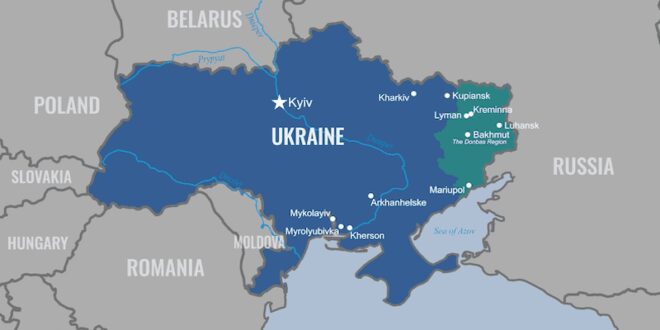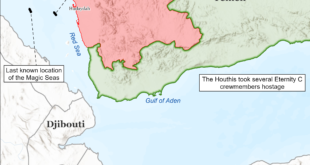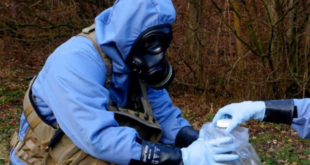- Battlefield Assessment
Russian forces maintained offensive combat operations along multiple axes. In eastern and northeastern Ukraine, Russian units assaulted areas near Bakhmut and in the outer rings of Kharkiv, and secured marginal advances in ground attacks around Chasiv Yar and Avdiivka. In southern Ukraine, the Kremlin’s forces scaled up offensive action around Kamianske in Zaporizhzhia Oblast.
Fierce battles raged on the Kharkiv axis, particularly near Vovchansk. Moscow continued to send inadequately equipped troops to their death in large numbers in northeastern Ukraine, where the Ukrainian Armed Forces are enveloping and isolating the invading servicemen. Several sources confirm that Ukrainian units trapped and captured hundreds of Russian soldiers attempting a river crossing near the PJSC Volchansky Chemical Plant.
Moscow has increased its use of glide bombs to advance its multifront push. This tactic has allowed Russian forces to conduct more expansive ground operations and accelerate the destruction and depopulation of critical urban combat zones, a long-standing Kremlin strategy since its wars in Chechnya in the 1990s. Last week Moscow targeted a three-story building in Kharkiv with a FAB-3000 glide bomb from a Sukhoi-34 fighter-bomber, the first documented employment of the munition in Ukraine. This giant weapon, which weighs over three tons, lacks the aerodynamics and precision of smaller smart munitions but has a massive kill radius that makes it a formidable asset.
Last, the Ukrainian military continued to unleash Army Tactical Missile System (ATACMS) salvos upon occupied Crimea.
- Kim Jong Un and Vladimir Putin Cement a Strategic Partnership Framework
Last week Russian President Vladimir Putin flew to Pyongyang to ink a strategic partnership treaty with his North Korean counterpart, Kim Jong Un. News outlets reported that the agreement committed both parties to providing military assistance to the other in the event either country is attacked.
While the medium- to long-term implications of this defense pact are still unclear, it has undoubtedly strengthened relations between Russia and North Korea at a time when Pyongyang is already providing Moscow with millions of artillery shells and a number of tactical ballistic missiles. Some have suggested that Putin used his visit to North Korea to renew orders for critical materiel, including ammunition and 152mm artillery shells.
- Ukraine’s Western Allies Boost Aid to Kyiv and Consider Further Increases
Western countries are increasing assistance to Kyiv to bolster Ukraine’s ability to fight Russian aggression. The Summit on Peace in Ukraine, held last week in Switzerland, focused on laying out a roadmap to end the Russian invasion.
An increasing number of Western allies are also taking more concrete steps and ramping up military assistance to Ukraine. Several allied countries, including the Netherlands and Romania, agreed to transfer Patriot strategic air and missile defense systems to Kyiv to bolster its air defenses.
Ukrainian news outlets also reported that the United States is considering closing all open orders for Patriots and redirecting its available systems to Kyiv. At the recent Eurosatory defense exhibition in Paris, several manufacturers of ammunition and artillery shells called on the European Union to rapidly boost its industrial capacity so that it can meet the target set by the Act Supporting Ammunition Production (ASAP), which aims to provide Ukraine with two million shells per year by the end of 2025.
The burgeoning defense ties between Russia and North Korea have also encouraged South Korea to consider revising its restrictions on military aid to Ukraine, which thus far has been limited to nonlethal equipment. A change of perspective in Seoul could help turn the tide in Ukraine. South Korea has resources, such as 105mm howitzer rounds, that Kyiv desperately needs. According to its own assessments, South Korea has a reserve of approximately 3.5 million 105mm howitzer rounds; releasing even a fraction of this stockpile would greatly assist Ukraine.
- Iran’s Arash Loitering Munitions Enter the Fight
Citing posts on Russian social media and Iranian announcements, several news outlets claimed this week that the Kremlin has ordered Arash kamikaze drones from Tehran. Ukrainian reports confirm that Iranian instructors have previously trained Russian operators in Iran on how to use these drones. Russia’s mixed strike packages will now include advanced Arash loitering munitions, developed by Tehran to target cities in Israel, in addition to Shahed drones.
Visual evidence suggests that Russia used the Arash-1 or Arash-2 in a recent aerial attack around the Ukrainian city of Mykolaiv. The Arash-2 is the more sophisticated variant of the drone, with a reported range of 1,200 miles and a destructive warhead. Along with carrying out high-precision strike missions, the Arash-2 can conduct reconnaissance operations to help long-range ballistic missiles locate targets. Its active guidance qualities, including a secure communications link with its operator, make the Arash-2 a dangerous precision strike asset.
 Eurasia Press & News
Eurasia Press & News


